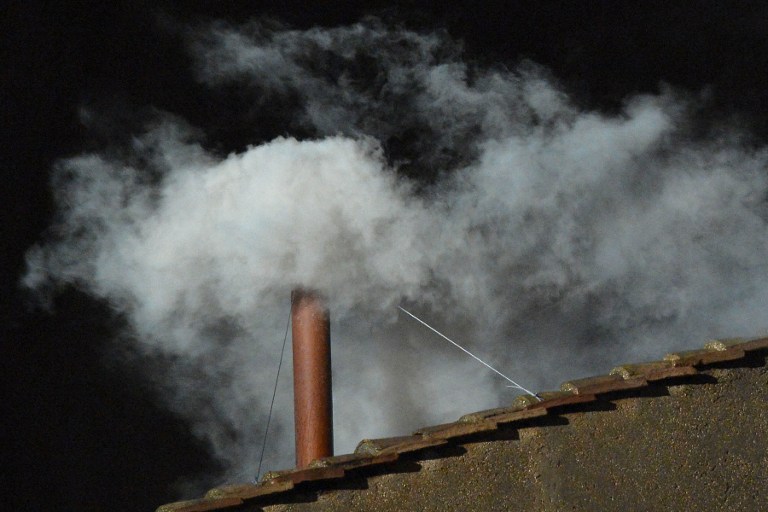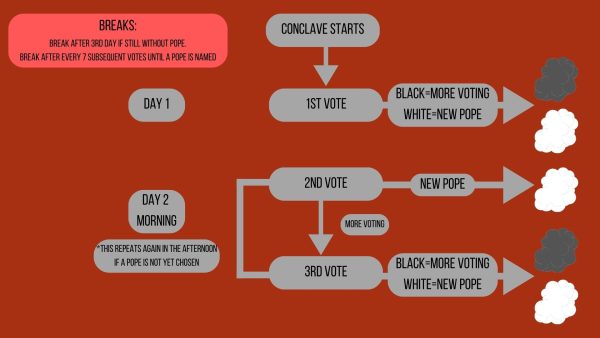
AFP
White smoke rises from the chimney on the roof of the Sistine Chapel meaning that cardinals elected a new pope on the second day of their secret conclave on March 13, 2013 at the Vatican. AFP PHOTO / VINCENZO PINTO
The process of electing a new Pontiff is one of immense secrecy. After Pope Francis’ death on April 21, the process to elect a new Pope began. Before the secret process begins, all of the death rituals are carried out in Rome. For Pope Fancis this included his viewing, funeral and the burial in the Basilica of Saint Mary. As soon as the Pope dies, the church enters the “Sede Vacante“, which is a time of transition. Sede Vacante is a Latin phrase that directly translates to English as, “the seat being vacant.” During this time, no major decisions for the church can be made.
In the weeks between the death of the Pope and the conclave, the cardinals meet in congregation meetings to present brief speeches about the direction they see the Church needing to go. While the cardinals are not allowed to campaign for the papacy since this is a role that is to be spiritually guided, it is a time for the cardinals to share how they see the Church moving forward should they become Pope, to inform cardinals along the voting process.
After a special Mass with the cardinals, they head to the Sistine Chapel for the conclave. Before the conclave can begin a few important secrecy measures are taken. All of the voting cardinals (those 80 years or younger) take a vow of secrecy as a group. This is followed by each cardinal advancing toward the altar, placing a hand on the Bible and taking an individual vow of secrecy. Should they break this vow, they are automatically excommunicated from the Church. Finally, the Master of Ceremonies announces, “Extra Omnes,” which translates to “all outside.” This is the cue for all security and non-essential staff to exit the chapel, at which point the Master of Ceremonies firmly shuts and locks the medieval doors and the conclave can begin.
The voting process occurs as follows:

Why they successfully get a two-thirds majority then the new Pontiff is elected, the ballots are burned, and white smoke billows from the chimney. If a majority is not reached, then the ballets are burned to make black smoke. White smoke is made by adding Potassium chlorate, Lactose and Rosin to the ballots as they are burning, whereas Black smoke is made by adding Potassium perchlorate, Anthracene, and Sulfur. These additives cause incomplete combustion leaving particles in the air giving the smoke color. For the 2025 Election of Pope Leo XIV, there were 133 voting members, meaning that 89 votes constituted the majority. These smoke signals are the only communication that the cardinals have to the outside world, as all phones, devices and other communication tools are turned in before the conclave begins. In 2013, signal blockers were installed in the Sistine Chapel prior to the conclave that elected the late Pope Francis, to further insure total privacy and secrecy in this modern age of technology.
The 2025 conclave began on May 7th, and white smoke smoke emerged around 6 p.m. Rome time (11 a.m. central time) on May 8th. The vote on May 7th took longer than much of the media and viewers had expected, as the time from the Sistine Chapel Doors closing to the time black smoke was seen was around three hours. After the first two votes on the morning of May 8th were in, black smoke was seen. Given the timing of the white smoke, it can be inferred that this came from the first vote of the afternoon, but it is not known for certain.
According to the New York Times, “Since 1900, this is the fifth pope to have been elected in two days,” and this is the third consecutive time that the Pontiff has been elected in the afternoon of the second day.
After being elected, the Pontiff goes to the Room of Tears to don his white vestments and mourn the gravity of the role they are taking on. During this election, just over an hour after white smoke was spotted, Cardinal Dominique François Joseph Mamberti emerged onto the balcony of Saint Peter’s Basilica in front of the red drapes to announce that the new Pontiff is Robert Francis Prevost and has taken the name Pope Leo XIV. The voting cardinals joined on the balconies of Saint Peter’s Basilica to await the arrival of the new Pope. From here, the new Pope delivers his first blessing and shares a few words about his vision of the Church.